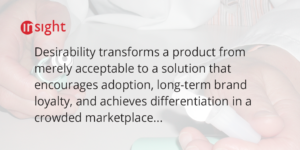Craig Scherer talks about the importance of desirability when trying to achieve differentiation in a crowded marketplace in his latest Med Device Online article

Over the last few years, the term human factors engineering has become permanently and inextricably linked with any discussions on effective and appropriate medical device development. Human factors are used to optimize designs to users’ capabilities while minimizing the negative consequences of their limitations.
With the adoption of the AAMI HE75 guidance, the FDA’s expectations around how to utilize effective human factors for device development has become better understood and more widely embraced. Clinicians and lay users alike have specific and significant use-related challenges that need to be addressed by device developers. The FDA’s oversight helps to ensure that devices cannot be misused in ways that can cause accidental harm. Implementing a sound human factors plan offers device companies additional benefits, like lower training and in-service costs, minimized probability of recall, and diminished frequency of liability litigation.
However, the truth is that the FDA is not concerned with your devices’ sales numbers, adoption rates, or any other indicators of market success. It exists to ensure that your device is safe and clinically effective. Looking at the bright side, though, the FDA human factors guidelines require multiple rounds of formative research, and this research, if appropriately designed, can be leveraged to create more user-centric and appropriate solutions.
